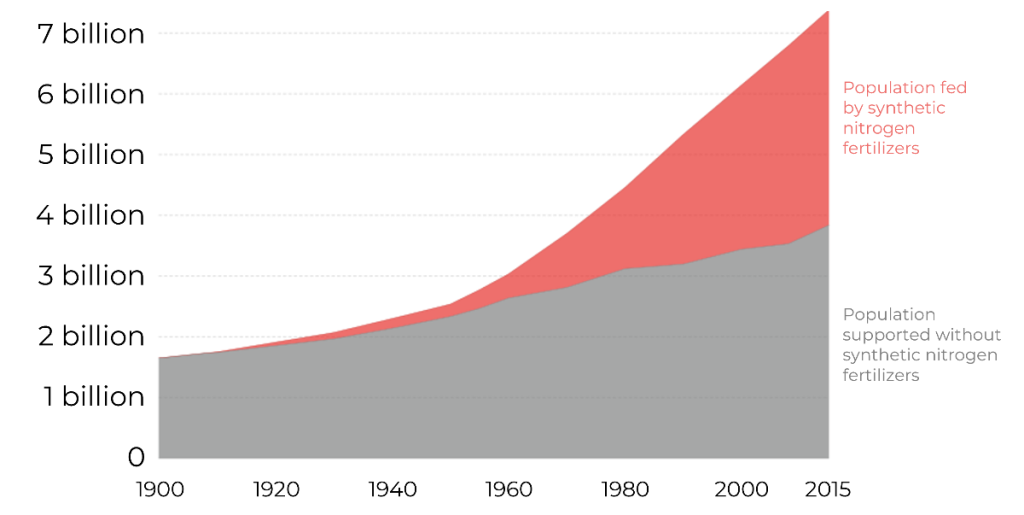Is Ammonia the Fuel of the Future?

Ammonia is about to get a promotion, moving beyond cleaning products and fertilizers and emerging as a potential fuel of the future. On Monday, Spanish oil and gas company Cepsa agreed to send ammonia to the Netherlands starting in 2027 for use as an alternative to natural gas.
Background: Ammonia is one of the most important chemicals ever created by mankind, responsible for feeding half the world’s population. It was first commercialized in the early 1900s through the Haber-Bosch process where hydrogen and nitrogen are combined over an iron catalyst at high pressure and temperature.
- Most ammonia facilities are combined with plants that produce hydrogen from fossil fuels, making the entire process energy intensive and producing 1.3 percent of global carbon dioxide emissions.
Ammonia is a $60 billion industry and ~80 percent of all ammonia produced today is used to make fertilizer.
World population supported by nitrogen fertilizers from the Haber-Bosch process

But there is increasing potential for this industry to not only grow plants but be used as a hydrogen carrier and sustainable fuel.
Ammonia as a hydrogen carrier
Many are looking at hydrogen as a key player in a net-zero future, but transporting it is not easy or cheap.
Doing so requires expensive liquefaction facilities and the need for the liquid hydrogen to be refrigerated at temperatures approaching absolute zero just to stay as a liquid during its ocean journey. To be used as an energy source, the hydrogen must then be extracted from the ammonia, which adds additional cost.
- Unfortunately, because of the low energy density of liquid hydrogen, a full tanker just isn’t that valuable, making the economics of the whole trip difficult.
Enter ammonia: In its liquid phase, ammonia can both be transported easily and contains more hydrogen than the same volume of pure liquid hydrogen (weird, but true). That means a tanker of the same size full of ammonia has more energy and is therefore more valuable.
Comparison between different storage technologies, including ammonia

Ammonia as a fuel
As a fuel, ammonia can be used in two ways.
- Through combustion: Ammonia combusted with oxygen has potential in the shipping industry. Companies like Hapag-Lloyd and Mitsubishi are currently looking at using ammonia as a bunker fuel, but will need special equipment if it’s to be circulated on ships as a fuel.
- Used in fuel cells: Converting ammonia into hydrogen and then used in a fuel cell would provide an alternative to trucking fuel. As it happens, this could also be applied to the shipping industry.
Green ammonia production: To make the whole process environmentally friendly, there are ongoing efforts to produce green ammonia by electrifying the Haber-Bosch process using renewable energy combined with green hydrogen production.
There are even technologies looking at “pee-cycling”, pulling ammonia from – you guess it – pee, taking the concept of circular economy to a new level.
It’s is not without its risks
Effective as a cleaning product and killing germs, ammonia has the potential to harm marine life if an accident occurs at sea. The ammonia hydroxide that would be created from a single tanker spill could sterilize several square miles of ocean.
If ocean-based transportation of the fuel is used more widely, the risks of a spill increase.
Zoom out: Money is already flowing into new ammonia uses. A recent $6 billion project in Canada was just approved to send hydrogen/ammonia to Germany. Japan is also hopping on the ammonia train as it looks to convert some of its LNG terminals into accepting ammonia then running power plants using the chemical.
Time will tell what role ammonia plays in the path toward decarbonization, but the ground is fertile for the growth of this industry.
+Bonus infographic: Agriculture: How Much Land is Needed to Feed One Person?




